Hendrik_2000
Lieutenant General
Good write up about J 15 from Red samovar
And this is where the subject becomes particularly interesting; indeed, China did not just make reverse engineering by creating the J-15 based on the T-10K-7. She continued the development of the latter first by making it versatile, then developing training versions, electronic warfare and finally a catapultable version. Where a Su-33 is a device limited to air superiority missions (primarily for doctrinal reasons) and with limited ground attack capabilities; China has been able to evolve the base platform to create a prolific and versatile set of embedded devices that meet its immediate and future needs.
Basic variant with which everything started; the Shenyang J-15 is the version that has the greatest similarity to the Su-33. Designed as an all-weather, all-purpose aircraft, the J-15 creation program was launched in 2006 and follows the detailed study of the T-10K-7 acquired in 2001 by China.
It took only 5 years (2001-2006) for China to study, understand and detail the needs for the creation of its own aircraft; once the program is launched, it will only be 3 years (2006-2009) before the flight of a first local prototype (the 551 Rouge) on August 31, 2009. It is the manufacturer Shenyang Aircraft Corporation (Institute 601) which will be responsible for the development of the device, this being the most logical: this manufacturer was responsible for assembling kits Su-27SK (known locally as the J-11) and he has developed the local (and more modern) variants of J-11 which will also give rise to the J-16.
This is the J-15 that we will see in more detail below.
The J-15, a little technique
As we will see below, there are several variants of J-15 some of which are still under development. For the technical details, we will rely only on the J-15 (only version currently in active service) and in view of the lacunary side of the technical information available; we will leave Su-33 to get the confirmed technical elements.
However, it is quite obvious that this information is addressed with the usual reservations and that in the absence of official information; we will deliberately leave aside certain aspects relating to this device.
Description and design
A versatile on-board unit developed by the 601 Institute (Shenyang), the J-15 Flying Shark is a near-identical copy (at first sight) of the T-10K-7 and therefore of the Sukhoi Su-33; comparison is not right and if the Su-33 is limited to air superiority missions, the J-15 has much broader skills that can be summarized in three points:
It is also true that doctrinally, the "Soviet" aircraft carrier (which will inherit Russia) is conceived as a defensive weapon while the Chinese aircraft carrier seems to be conceived more in an offensive perspective.
Where the device also differs from the Su-33, it is at the level of the structure: Shenyang made use of composite materials on certain zones of the apparatus (in particular at the level of the fins and horizontal stabilizers) which makes it possible to lighten the latter and thus lighten its empty weight.
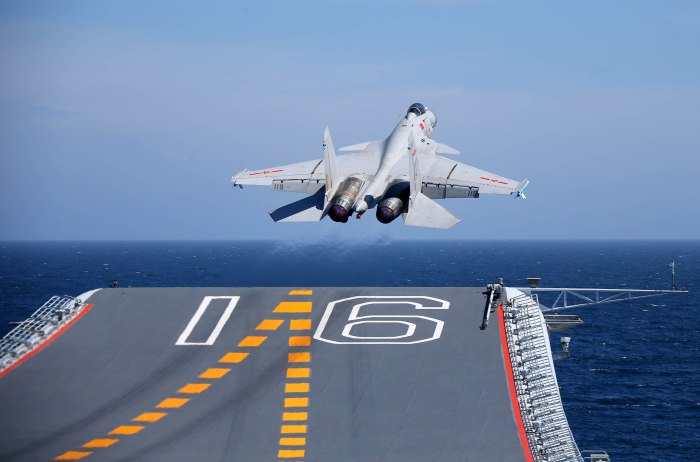
J-15 No. 119 at the time of take-off. Photo @ China Military Online
In fact, some of the work done by China on J-11 and its local adaptations (J-11B) were taken over and integrated within J-15 to have a device "similar" to other local productions and accelerate the development of the latter through the use of technological bricks already developed.
Overall dimensions
Responsible for the protection of the air carrier group and whatever it is by obtaining air superiority or the attack of the enemy surface ships, the J-15 is a heavy and imposing device which can absolutely not disavow his affiliation to Su-27 Flanker .
Classified in generation 3 devices (equivalent in the West to generation 4 ) that will eventually give way to a generation 4 device (so generation 5 in the West ...), it is nonetheless a modern and credible device face to any potential opponent for China.
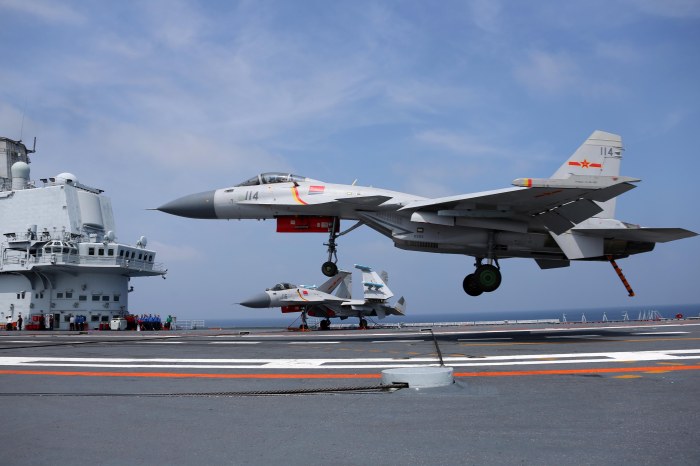
Seized the moment it goes to touch the stopper: the J-15 n ° 14. Photo @ China Military Online
In terms of overall dimensions, which are for the most part identical to those of Su-33, the following figures are available:
Length: 21.19 m
Wingspan: 14.7 m
Wingspan with folded wings: 8.4 m (Su-33: 7.4 m)
Height: 5.72 m
Wing area: 67.84 m² Curb
weight: 17, 5 tonnes (Su-33: 18.4 tonnes)
Payload: 6.5 tonnes
Gross weight: 29.94 tonnes
Maximum take-off
weight : 33 tonnes Maximum landing weight: 24.5 tonnes
The landing gear is exactly the same as that of the Su-33: a double front wheel mounted slightly behind the cockpit and two main trains with one wheel mounted along the reactors; all with powerful dampers to absorb the impact of the deck.
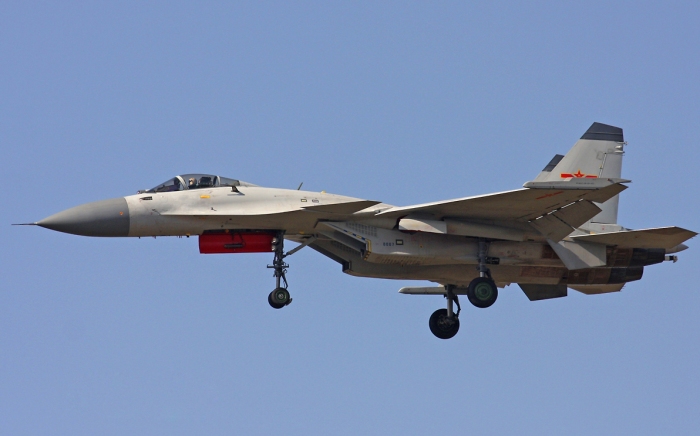
This prototype J-15 allows to see the configuration of the landing gear of the aircraft. Photo@?
On the basis of available photos, the wing folding system has been slightly modified compared to the Su-33 for a reason that has not been specified so far.
Engines
The Shenyang J-15 has two Saturn AL-31F series 3 engines (Izd.99A), the latter being identical to those fitted to the Su-33. This is a modified variant of the AL-31F engine fitted to the Su-27 and featuring emergency afterburner and enhanced corrosion protection.
Each engine has a power of:
75.2 kN dry
122.5 kN afterburner
125.5 kN in emergency afterburner
The thrust / weight ratio offered by the AL-31F series 3 is estimated at 0.83.
It is well-known that progress in the development of Chinese indigenous engines has been slow and complex, forcing local decision-makers to continue to equip Russian engines during the development and refinement of local engines. . The J-15 is no exception; some prototypes are still equipped with the Saturn AL-31F series 3 engine (Izd 99A) while others will test a Chinese engine: the Shenyang WS-10 (H) .
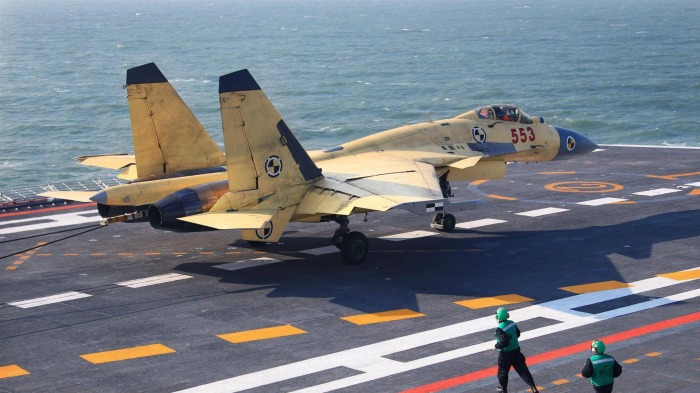
This photo of the prototype 553 Red allows to see the AL-31F and their characteristic nozzles. [email protected]
This new turbofan engine developed by the 606 Institute is the Chinese response to the current import of AL-31F to equip its local productions; the engine has had a long and delicate phase of development and maturation which saw its entry into service be done gradually on some prototypes before starting to equip J-10, J-11, J-15 (prototypes) and J-16. According to figures available on the Internet, it would offer a power gain compared to the AL-31F series 3 with a power of 132 kN post-combustion: this increase in power coupled with a decrease in the mass of the device would offer performance gains for the least interesting.
The J-15 series already produced are all equipped with AL-31F series 3 engines, however, it is said that the next batches of devices to produce and / or new variants would pass directly on WS-10 (H) if the latter came to give full and complete satisfaction.
The J-15 can be refueled in flight via a retractable boom mounted at the front of the cockpit to the left of the pilot. The on-board system can receive 2,300 liters of fuel per minute and the total fuel capacity of the aircraft is 9.5 tons of fuel.
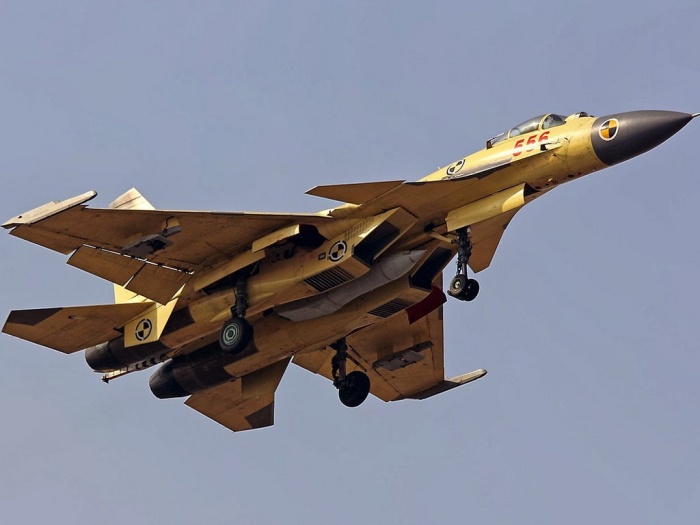
The prototype 556 Red with pod UPAZ-1A in central port. [email protected]
In addition, the J-15 has a central point "wet" (located between the reactors) on which can be mounted UPAZ-1A pod to supply other devices (principle of " buddy refueling "), the latter offering a flow rate of 1,000 L / minute.
performances
The maximum speed of the aircraft is capped at 2,300 km / h (in smooth configuration) at altitude while the maximum speed at sea level is 1,300 km / h.
Thanks to its configuration with ducks and fins, the J-15 has a reduced approach speed compared to a Su-27 / J-11; the aircraft can land at 240 km / h (a J-11 can not descend below 270 km / h under penalty of stall). The wing load of the device is 483 Kg / m².
And this is where the subject becomes particularly interesting; indeed, China did not just make reverse engineering by creating the J-15 based on the T-10K-7. She continued the development of the latter first by making it versatile, then developing training versions, electronic warfare and finally a catapultable version. Where a Su-33 is a device limited to air superiority missions (primarily for doctrinal reasons) and with limited ground attack capabilities; China has been able to evolve the base platform to create a prolific and versatile set of embedded devices that meet its immediate and future needs.
Basic variant with which everything started; the Shenyang J-15 is the version that has the greatest similarity to the Su-33. Designed as an all-weather, all-purpose aircraft, the J-15 creation program was launched in 2006 and follows the detailed study of the T-10K-7 acquired in 2001 by China.
It took only 5 years (2001-2006) for China to study, understand and detail the needs for the creation of its own aircraft; once the program is launched, it will only be 3 years (2006-2009) before the flight of a first local prototype (the 551 Rouge) on August 31, 2009. It is the manufacturer Shenyang Aircraft Corporation (Institute 601) which will be responsible for the development of the device, this being the most logical: this manufacturer was responsible for assembling kits Su-27SK (known locally as the J-11) and he has developed the local (and more modern) variants of J-11 which will also give rise to the J-16.
This is the J-15 that we will see in more detail below.
The J-15, a little technique
As we will see below, there are several variants of J-15 some of which are still under development. For the technical details, we will rely only on the J-15 (only version currently in active service) and in view of the lacunary side of the technical information available; we will leave Su-33 to get the confirmed technical elements.
However, it is quite obvious that this information is addressed with the usual reservations and that in the absence of official information; we will deliberately leave aside certain aspects relating to this device.
Description and design
A versatile on-board unit developed by the 601 Institute (Shenyang), the J-15 Flying Shark is a near-identical copy (at first sight) of the T-10K-7 and therefore of the Sukhoi Su-33; comparison is not right and if the Su-33 is limited to air superiority missions, the J-15 has much broader skills that can be summarized in three points:
- Air superiority and fleet coverage
- Attack of surface ships
- Attack of ground objectives
It is also true that doctrinally, the "Soviet" aircraft carrier (which will inherit Russia) is conceived as a defensive weapon while the Chinese aircraft carrier seems to be conceived more in an offensive perspective.
Where the device also differs from the Su-33, it is at the level of the structure: Shenyang made use of composite materials on certain zones of the apparatus (in particular at the level of the fins and horizontal stabilizers) which makes it possible to lighten the latter and thus lighten its empty weight.

J-15 No. 119 at the time of take-off. Photo @ China Military Online
In fact, some of the work done by China on J-11 and its local adaptations (J-11B) were taken over and integrated within J-15 to have a device "similar" to other local productions and accelerate the development of the latter through the use of technological bricks already developed.
Overall dimensions
Responsible for the protection of the air carrier group and whatever it is by obtaining air superiority or the attack of the enemy surface ships, the J-15 is a heavy and imposing device which can absolutely not disavow his affiliation to Su-27 Flanker .
Classified in generation 3 devices (equivalent in the West to generation 4 ) that will eventually give way to a generation 4 device (so generation 5 in the West ...), it is nonetheless a modern and credible device face to any potential opponent for China.

Seized the moment it goes to touch the stopper: the J-15 n ° 14. Photo @ China Military Online
In terms of overall dimensions, which are for the most part identical to those of Su-33, the following figures are available:
Length: 21.19 m
Wingspan: 14.7 m
Wingspan with folded wings: 8.4 m (Su-33: 7.4 m)
Height: 5.72 m
Wing area: 67.84 m² Curb
weight: 17, 5 tonnes (Su-33: 18.4 tonnes)
Payload: 6.5 tonnes
Gross weight: 29.94 tonnes
Maximum take-off
weight : 33 tonnes Maximum landing weight: 24.5 tonnes
The landing gear is exactly the same as that of the Su-33: a double front wheel mounted slightly behind the cockpit and two main trains with one wheel mounted along the reactors; all with powerful dampers to absorb the impact of the deck.

This prototype J-15 allows to see the configuration of the landing gear of the aircraft. Photo@?
On the basis of available photos, the wing folding system has been slightly modified compared to the Su-33 for a reason that has not been specified so far.
Engines
The Shenyang J-15 has two Saturn AL-31F series 3 engines (Izd.99A), the latter being identical to those fitted to the Su-33. This is a modified variant of the AL-31F engine fitted to the Su-27 and featuring emergency afterburner and enhanced corrosion protection.
Each engine has a power of:
75.2 kN dry
122.5 kN afterburner
125.5 kN in emergency afterburner
The thrust / weight ratio offered by the AL-31F series 3 is estimated at 0.83.
It is well-known that progress in the development of Chinese indigenous engines has been slow and complex, forcing local decision-makers to continue to equip Russian engines during the development and refinement of local engines. . The J-15 is no exception; some prototypes are still equipped with the Saturn AL-31F series 3 engine (Izd 99A) while others will test a Chinese engine: the Shenyang WS-10 (H) .

This photo of the prototype 553 Red allows to see the AL-31F and their characteristic nozzles. [email protected]
This new turbofan engine developed by the 606 Institute is the Chinese response to the current import of AL-31F to equip its local productions; the engine has had a long and delicate phase of development and maturation which saw its entry into service be done gradually on some prototypes before starting to equip J-10, J-11, J-15 (prototypes) and J-16. According to figures available on the Internet, it would offer a power gain compared to the AL-31F series 3 with a power of 132 kN post-combustion: this increase in power coupled with a decrease in the mass of the device would offer performance gains for the least interesting.
The J-15 series already produced are all equipped with AL-31F series 3 engines, however, it is said that the next batches of devices to produce and / or new variants would pass directly on WS-10 (H) if the latter came to give full and complete satisfaction.
The J-15 can be refueled in flight via a retractable boom mounted at the front of the cockpit to the left of the pilot. The on-board system can receive 2,300 liters of fuel per minute and the total fuel capacity of the aircraft is 9.5 tons of fuel.

The prototype 556 Red with pod UPAZ-1A in central port. [email protected]
In addition, the J-15 has a central point "wet" (located between the reactors) on which can be mounted UPAZ-1A pod to supply other devices (principle of " buddy refueling "), the latter offering a flow rate of 1,000 L / minute.
performances
The maximum speed of the aircraft is capped at 2,300 km / h (in smooth configuration) at altitude while the maximum speed at sea level is 1,300 km / h.
Thanks to its configuration with ducks and fins, the J-15 has a reduced approach speed compared to a Su-27 / J-11; the aircraft can land at 240 km / h (a J-11 can not descend below 270 km / h under penalty of stall). The wing load of the device is 483 Kg / m².



